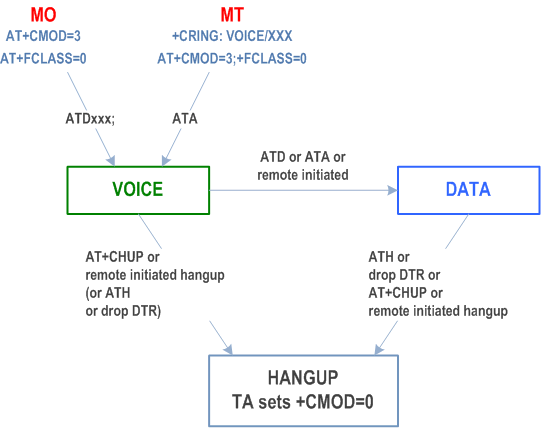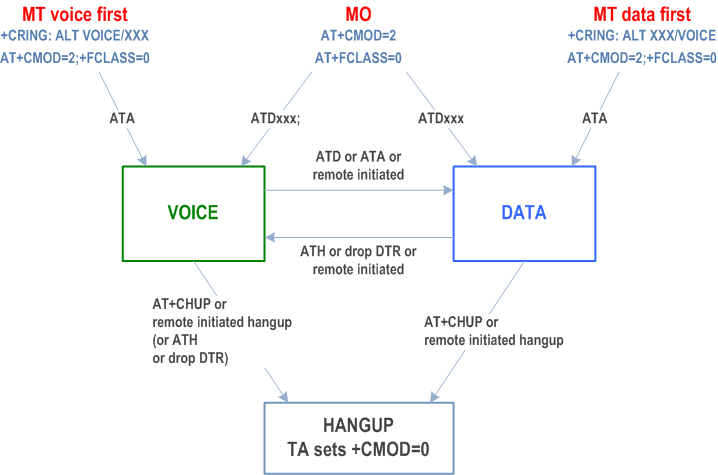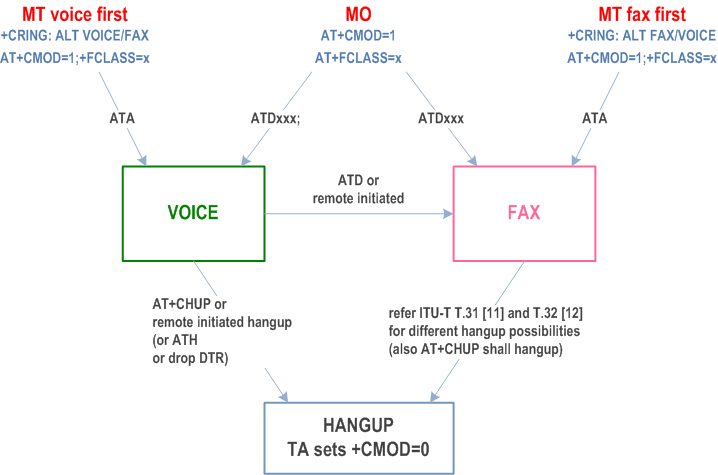Content for TS 27.007 Word version: 18.7.0
1…
4…
5…
6…
6.10…
6.20…
7…
7.10…
7.20…
7.30…
7.40…
8…
8.10…
8.20…
8.30…
8.40…
8.50…
8.55
8.56…
8.60…
8.70…
8.80…
9…
10…
10.1.3…
10.1.10…
10.1.20…
10.1.30…
10.1.40…
10.1.50…
10.1.60…
10.1.70…
10.1.80…
10.2…
11…
12…
13…
14…
15…
16…
17…
18…
19…
A
B
C…
E
F
G…
6 Call control commands and methods
6.0 General
6.1 Select type of address +CSTA
6.2 ITU-T Recommendation V.250 [14] dial command D
6.3 Direct dialling from phonebooks
6.4 Call mode +CMOD
6.4A Voice call mode +CVMOD
6.5 Hangup call +CHUP
6.6 Alternating mode call control method
6.7 Select bearer service type +CBST
6.8 Radio link protocol +CRLP
6.9 Service reporting control +CR
...
...
6 Call control commands and methods p. 34
6.0 General |R8| p. 34
This clause describes the control of calls. Normal data and fax call control is done as in ITU-T Recommendation V.250 [14], ITU-T Recommendation T.31 [11] and ITU-T Recommendation T.32 [12]. For voice call originating, refer to clause "ITU-T Recommendation V.250 dial command D" and clause "Commands for enhanced support of dialling".
6.1 Select type of address +CSTA p. 34
| Command | Possible response(s) |
|---|---|
| +CSTA=[<type>] | |
| +CSTA? | +CSTA: <type> |
| +CSTA=? | +CSTA: (list of supported <type>s) |
Description
Set command selects the type of number for further dialling commands (D) according to TS 24.008.
Read command returns the current value of <type>.
Test command returns values supported as a compound value.
Defined values
<type>
Implementation
type of address octet in integer format (refer to clause 10.5.4.7 of TS 24.008); default 145 when dialling string includes international access code character "+", otherwise 129.
Mandatory when other than default value allowed.
6.2 ITU-T Recommendation V.250 [14] dial command D p. 34
ITU-T Recommendation V.250 [14] dial command D lists characters that may be used in a dialling string for making a call or controlling supplementary services in accordance with TS 22.030. Their use is listed in this clause, as well as new dial modifiers are introduced. For an MT supporting AT commands only, it is mandatory to support the control of supplementary services in accordance with TS 22.030 through the dial command or through the specific supplementary service commands (+CCFC, +CLCK, etc.), where TS 22.030 identifies the supplementary services as mandatory. See also the AT commands for enhanced support of dialling as well as +CMCCS and +CLCCS.
V.250 dialling digits
1 2 3 4 5 6 7 8 9 0 * # + A B C
V.250 modifier characters
(implementation of these characters is mandatory)
D
(implementation of this character is optional, and it is ignored)
,
V.250 semicolon character
(implementation of this character is mandatory, but it may be ignored)
T P
(implementation of these characters is mandatory, but they are ignored)
! W @
(implementation of these characters is optional, and they are ignored)
When semicolon character is given after dialling digits (or modifiers), a voice call originated to the given address. TA returns to command state immediately (or after possible +COLP result code; refer to clause "Connected line identification presentation +COLP"). Refer Annex G for a detailed example.
Modifier characters
>
(refer to clause "Direct dialling from phonebooks")
I or i
(override the CLIR supplementary service subscription default value for this call; I = invocation (restrict CLI presentation) and i = suppression (allow CLI presentation); refer to clause "Calling line identification restriction +CLIR").
G or g
(control the CUG supplementary service information for this call; uses index and info values set with command +CCUG or +CECUG; refer to clause "Closed user group +CCUG" and clause "Enhanced closed user group +CECUG").
6.3 Direct dialling from phonebooks p. 35
MT and SIM/UICC can contain phonebooks which have a phone number and an alphanumeric field for each phonebook entry location. The use of ITU-T Recommendation V.250 [14] dialling command ensures that direct dialling from MT and SIM/UICC phonebook is possible through ordinary communications software which just gives the phone number field to be filled and then use the D command to originate the call. Available memories may be queried with Select Phonebook Storage test command +CPBS=?, and location range for example with Read Phonebook Entries test command +CPBR=?.
Execute commands
1. D><str>[I][G][;]
Responses
originate call to phone number which corresponding alphanumeric field is <str> (if possible, all available memories should be searched for the correct entry).
2. D>mem<n>[I][G][;]
originate call to phone number in memory mem entry location <n> (available memories may be queried with Select Phonebook Storage test command +CPBS=?; mem could be e.g. ME).
3. D><n>[I][G][;]
originate call to phone number in entry location <n> (it is manufacturer specific which memory storage of MT, SIM/UICC in the currently selected card slot and TA is used; command Select Phonebook Memory Storage +CPBS setting is recommended to be used).
Semicolon character shall be added when voice call is originated. CLIR and CUG per call base modifiers may also be present.
Possible error responses include +CME ERROR: <err> when error is related to MT functionality. Refer to clause 9.2 for possible <err> values. Otherwise TA responses can have values defined by ITU-T Recommendation V.250 [14] and commands Service Reporting Control +CR and Connected Line Identification Presentation +COLP. Detailed error report of an unsuccessful originated call failed in the network error can be obtained with command Extended Error Report +CEER (if implemented).
Defined values
<str>
Implementation
string type value, which should equal to an alphanumeric field in at least one phonebook entry in the searched memories; used character set should be the one selected with command select TE character set +CSCS.
<n>
integer type memory location should be in the range of locations available in the memory used.
Mandatory when direct dialling is implemented. Also phonebook commands implementation is required.
6.4 Call mode +CMOD p. 36
| Command | Possible response(s) |
|---|---|
| +CMOD=[<mode>] | |
| +CMOD? | +CMOD: <mode> |
| +CMOD=? | +CMOD: (list of supported <mode>s) |
Description
Set command selects the call mode of further dialling commands (D) or for next answering command (A). Mode can be either single or alternating (in the present document, terms "alternating mode" and "alternating call" refer to all GSM/UMTS bearer and teleservices that incorporate more than one basic service (voice, data, fax) within one call). When single mode is selected the call originating and hangup procedures are similar to procedures specified in ITU-T Recommendations V.250 [14], T.31 [11] and T.32 [12]. In GSM/UMTS there can be voice followed by data (refer TS 22.002), alternating voice/data (refer TS 22.002) and alternating voice/fax calls (refer TS 22.003). See following clauses for alternating call control methods.
Read command returns the current value of <mode>.
Test command returns values supported as a compound value.
Defined values
<mode>
Implementation
integer type
0 (default)
single mode
1
alternating voice/fax (teleservice 61)
2
alternating voice/data (bearer service 61)
3
voice followed by data (bearer service 81)
all other values below 128 are reserved by the present document.
Mandatory when alternating mode calls are implemented in the TA.
6.4A Voice call mode +CVMOD |R8| p. 36
| Command | Possible response(s) |
|---|---|
| +CVMOD=[<voice_mode>] | |
| +CVMOD? | +CVMOD: <voice_mode> |
| +CVMOD=? | +CVMOD: (list of supported <voice_mode>s) |
Description
Set command selects the voice call mode for making a Mobile Originated voice call from the UE. The voice call mode can be CS_ONLY, VOIP_ONLY, CS_PREFERRED or VOIP_PREFERRED. Type of VoIP session preferred (e.g. SIP VoIP, IMS VoIP) is manufacturer specific issue.
Read command returns the current value of <voice_mode>.
Test command returns the values supported by the UE as a compound value.
Defined values
<voice_mode>
Implementation
integer type. The default value is manufacturer specific.
0
CS_ONLY
1
VOIP_ONLY
2
CS_PREFERRED
3
VOIP_PREFERRED
Optional.
6.5 Hangup call +CHUP p. 37
| Command | Possible response(s) |
|---|---|
| +CHUP | |
| +CHUP=? |
Description
Execution command causes the TA to hangup the current call of the MT.
Implementation
Mandatory when alternating mode calls implemented in the TA.
6.6 Alternating mode call control method p. 38
This clause describes the procedure to handle alternating mode calls with AT commands. Procedures are mandatory when alternating mode calls are implemented in the TA.
Voice followed by data call (bearer service 81)
Figure 4 shows commands to start the call, to switch from voice to data (In-Call Modification) and to hang up the call. +CMOD and +FCLASS commands indicate the current settings before dialling or answering command, not that they shall be given just before D or A command. Refer to clause "Cellular result codes +CRC" for possible +CRING result code values. Refer Annex F for a detailed example.

Voice/ data call (bearer service number 61)
Figure 5 shows the commands to start the call, to switch between modes (In-Call Modification) and to hang up the call. +CMOD and +FCLASS commands indicate the current settings before dialling or answering command, not that they shall be given just before D or A command. Refer to clause "Cellular result codes +CRC" for possible +CRING result code values. Refer Annex E for a detailed example.

Voice/ fax call (teleservice number 61)
Figure 6 shows the commands to start the call, to switch between modes (In-Call Modification) and to hang up the call. +CMOD and +FCLASS commands indicate the current settings before dialling or answering command, not that they shall be given just before D or A command. The parameter "x" of +FCLASS command can be 1, 1.0, 2 or 2.0.

6.7 Select bearer service type +CBST p. 39
| Command | Possible response(s) |
|---|---|
| +CBST=[<speed>[,<name>[,<ce>]]] | |
| +CBST? | +CBST: <speed>,<name>,<ce> |
| +CBST=? | +CBST: (list of supported <speed>s),(list of supported <name>s),(list of supported <ce>s) |
Description
Set command selects the bearer service <name> with data rate <speed>, and the connection element <ce> to be used when data calls are originated (refer TS 22.002). Values may also be used during mobile terminated data call setup, especially in case of single numbering scheme calls (refer +CSNS).
Read command returns the current parameter values.
Test command returns values supported as compound values.
Defined values
<speed>
Implementation
integer type
0
<name>
autobauding (automatic selection of the speed; this setting is possible in case of 3.1 kHz modem and non-transparent service)
1
300 bps (V.21)
2
1200 bps (V.22)
3
1200/75 bps (V.23)
4
2400 bps (V.22bis)
5
2400 bps (V.26ter)
6
4800 bps (V.32)
7
9600 bps (V.32)
12
9600 bps (V.34)
14
14400 bps (V.34)
15
19200 bps (V.34)
16
28800 bps (V.34)
17
33600 bps (V.34)
34
1200 bps (V.120)
36
2400 bps (V.120)
38
4800 bps (V.120)
39
9600 bps (V.120)
43
14400 bps (V.120)
47
19200 bps (V.120)
48
28800 bps (V.120)
49
38400 bps (V.120)
50
48000 bps (V.120)
51
56000 bps (V.120)
65
300 bps (V.110)
66
1200 bps (V.110)
68
2400 bps (V.110 or X.31 flag stuffing)
70
4800 bps (V.110 or X.31 flag stuffing)
71
9600 bps (V.110 or X.31 flag stuffing)
75
14400 bps (V.110 or X.31 flag stuffing)
79
19200 bps (V.110 or X.31 flag stuffing)
80
28800 bps (V.110 or X.31 flag stuffing)
81
38400 bps (V.110 or X.31 flag stuffing)
82
48000 bps (V.110 or X.31 flag stuffing)
83
56000 bps (V.110 or X.31 flag stuffing; this setting can be used in conjunction with asynchronous non-transparent UDI or RDI service in order to get FTM)
84
64000 bps (X.31 flag stuffing; this setting can be used in conjunction with asynchronous non-transparent UDI service in order to get FTM)
115
56000 bps (bit transparent)
116
64000 bps (bit transparent)
120
32000 bps (PIAFS32k)
121
64000 bps (PIAFS64k)
130
28800 bps (multimedia)
131
32000 bps (multimedia)
132
33600 bps (multimedia)
133
56000 bps (multimedia)
134
64000 bps (multimedia)
all other values below 256 are reserved by the present document.
integer type
0
<ce>
data circuit asynchronous (UDI or 3.1 kHz modem)
1
data circuit synchronous (UDI or 3.1 kHz modem)
2
PAD Access (asynchronous) (UDI)
3
Packet Access (synchronous) (UDI)
4
data circuit asynchronous (RDI)
5
data circuit synchronous (RDI)
6
PAD Access (asynchronous) (RDI)
7
Packet Access (synchronous) (RDI)
all other values below 128 are reserved by the present document.
integer type
0
transparent
1
non-transparent
2
both, transparent preferred
3
both, non-transparent preferred
Mandatory when data calls implemented.
6.8 Radio link protocol +CRLP p. 42
| Command | Possible response(s) |
|---|---|
| +CRLP=[<iws>[,<mws>[,<T1>[,<N2>[,<ver>[,<T4>]]]]]] | |
| +CRLP? | +CRLP: <iws>,<mws>,<T1>,<N2>[,<ver1>[,<T4>]] [<CR><LF>+CRLP: <iws>,<mws>,<T1>,<N2>[,<ver2>[,<T4>]] [...]] |
| +CRLP=? | +CRLP: (list of supported <iws>s),(list of supported <mws>s), (list of supported <T1>s),(list of supported <N2>s)[,<ver1> [,(list of supported <T4>s)]] class="atrsp"[<CR><LF>+CRLP: (list of supported <iws>s),(list of supported <mws>s),(list of supported <T1>s),(list of supported <N2>s)[,<ver2>[,(list of supported <T4>s)]] [...]] |
Description
Radio link protocol (RLP) parameters used when non-transparent data calls are originated may be altered with set command. Available command subparameters depend on the RLP versions implemented by the device (e.g. <ver> may not be available if device supports only versions 0 and 1).
Read command returns current settings for each supported RLP version <verx>. Only RLP parameters applicable to the corresponding <verx> are returned.
Test command returns values supported as compound values. If MT/TA supports several RLP versions <verx>, the RLP parameter value ranges for each <verx> are returned on a separate line.
Defined values
<ver>, <verx>
Implementation
RLP version number in integer format; when version indication is not present it shall equal 0
<iws>, <mws>, <T1>, <N2>, <T4>
IWF to MS window size, MS to IWF window size, acknowledgement timer T1, retransmission attempts N2, re-sequencing period T4 in integer format (default values and value ranges depend on RLP version; refer TS 24.022): T1 and T4 are in units of 10 ms.
Mandatory when RLP implemented.
6.9 Service reporting control +CR p. 43
| Command | Possible response(s) |
|---|---|
| +CR=[<mode>] | |
| +CR? | +CR: <mode> |
| +CR=? | +CR: (list of supported <mode>s) |
Description
Set command controls whether or not intermediate result code +CR: <serv> is returned from the TA to the TE. If enabled, the intermediate result code is transmitted at the point during connect negotiation at which the TA has determined which speed and quality of service will be used, before any error control or data compression reports are transmitted, and before the intermediate result code CONNECT is transmitted.
Read command returns the current value of <mode>.
Test command returns values supported as a compound value.
Defined values
<mode>
Implementation
integer type
0 (default)
<serv>
disables reporting
1
enables reporting
ASYNC
<L2P>
asynchronous transparent
SYNC
synchronous transparent
REL ASYNC
asynchronous non-transparent
REL SYNC
synchronous non-transparent
GPRS [<L2P>]
GPRS
proposes a layer 2 protocol to use between the MT and the TE. It is defined in the Enter GPRS Data Mode (+CGDATA) command.
Mandatory when data calls implemented.